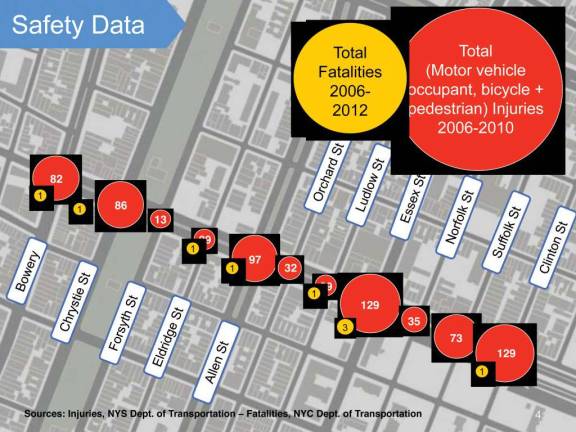Correcting Delancey

After a water main broke on Delancey Street early Tuesday morning, Feb. 14, the thoroughfare was an unfamiliar sight. Aside from the pools of brown-tinged water that collected on the road-and were at one point reportedly 3 feet high-the street, largely closed off to traffic, was vacant of cars with the exception of some Fire Department and other emergency vehicles.
Delancey Street, the main thoroughfare in the Lower East Side and the feeder onto and off the Williamsburg Bridge, is known for its congested traffic, especially during rush hour. The cacophony of horns and frustrated shouting isn't an unfamiliar soundtrack for a walk down this street at these peak times. And some would argue that pedestrians fare even worse, with long crosswalks-some as long as165 feet-paired with short traffic signals.
After a handful of fatalities over the past year-most recently Dashane Santana, a 12-year-old who attended nearby CASTLE Middle School-along with numerous vehicle and pedestrian accidents, the Department of Transportation (DOT) unveiled a proposal Wednesday, Feb. 8, to make Delancey Street safer. Introduced by Community Board 3's Transportation and Committee Chairman David Crane, Josh Benson of the DOT presented a slideshow of the proposed changes to a group of local residents, representatives of elected officials and CB3 members.
"It is rare to see a government agency move so quickly," said State Sen. Daniel Squadron, who spoke to the group at the end of meeting. "We know what a crisis Delancey is?this change taking months and not years is a big deal," he added.
According to the DOT's research, there have been a total of nine fatalities and over 700 vehicle, cyclist and pedestrian injuries from 2006-2010 on Delancey Street from the Bowery to Clinton Street. The presentation showed many pedestrian accidents were caused by turning vehicles not yielding to pedestrians, as well as long crosswalks and pedestrians not having enough time to cross.
With its access to the Williamsburg Bridge, Benson also pointed out that Delancey in many ways can seem like a highway to drivers, and the job of the DOT is to transform the thoroughfare into something perceived as a neighborhood street.
While the DOT has already implemented many safety measures on the thoroughfare-like creating safety islands and bicycle lanes and installing countdown clocks-more is needed and seems to be addressed in the new plan. The multilayered plan includes shortening the crosswalks, clarifying lanes of travel for drivers, altering signal timing and enhancing the bridge entrance, measures that can be quickly implemented without requiring structural changes to the road.
In mockups of what the updated intersections might look like, Benson showed painted, extended sidewalks with planters clearly demarcating where the sidewalk ends. This, Benson noted, would help shorten the distance pedestrians must travel to cross the street. Of the 19 crosswalks being looked at, Benson said 14 will be shortened. He highlighted the Clinton Street intersection, which will decrease by 49 feet from its current 165 feet.
Currently, the outer lanes of traffic are very wide, though not wide enough for parked cars and moving lanes of traffic, but better aligned road markings should clarify this issue. Left turns have also been cause for concern, and the plan includes eliminating three additional left turns-almost nine intersections already have left turn bans. Benson noted that the DOT also plans to open Clinton Street to vehicles to gain access to the bridge.
While many praised the plan, which the DOT hopes to enact in June, some suggested measures be implemented now to make the street safer. April Lewis, with the group Manhattan Together, brought up the question of why the light times couldn't be tweaked significantly now to give people sufficient time to cross. Benson pointed out that much longer lights could exacerbate traffic congestion, since a longer light at one intersection will create a shorter signal length at another crosswalk. He noted this plan could impact the flow of traffic and possibly lead to unsafe conditions for pedestrians. He did note, however, that the DOT is looking into lengthening the lights by a few seconds.
Others worried that allowing access onto the bridge from Clinton Street would also worsen traffic issues on the Delancey. Another attendee suggested creating signage showing people that they can cross at Pitt Street, a safer crosswalk, since most of the vehicular traffic has already gone onto the Williamsburg Bridge.
At the meeting, Crane noted that the committee didn't need to make any decisions about the plan that evening. The committee discussed it further at a Wednesday, Feb. 15, meeting and are likely to vote on the plan next month.
[gallery link="file" columns="1"]